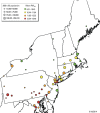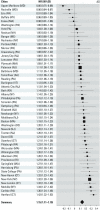Long-term PM2.5 Exposure and Neurological Hospital Admissions in the Northeastern United States
- PMID: 25978701
- PMCID: PMC4710596
- DOI: 10.1289/ehp.1408973
Long-term PM2.5 Exposure and Neurological Hospital Admissions in the Northeastern United States
Abstract
Background: Long-term exposure to fine particles (particulate matter ≤ 2.5 μm; PM2.5) has been consistently linked to heart and lung disease. Recently, there has been increased interest in examining the effects of air pollution on the nervous system, with evidence showing potentially harmful effects on neurodegeneration.
Objective: Our objective was to assess the potential impact of long-term PM2.5 exposure on event time, defined as time to first admission for dementia, Alzheimer's (AD), or Parkinson's (PD) diseases in an elderly population across the northeastern United States.
Methods: We estimated the effects of PM2.5 on first hospital admission for dementia, AD, and PD among all Medicare enrollees ≥ 65 years in 50 northeastern U.S. cities (1999-2010). For each outcome, we first ran a Cox proportional hazards model for each city, adjusting for prior cardiopulmonary-related hospitalizations and year, and stratified by follow-up time, age, sex, and race. We then pooled the city-specific estimates by employing a random effects meta-regression.
Results: We followed approximately 9.8 million subjects and observed significant associations of long-term PM2.5 city-wide exposure with all three outcomes. Specifically, we estimated a hazard ratio (HR) of 1.08 (95% CI: 1.05, 1.11) for dementia, an HR of 1.15 (95% CI: 1.11, 1.19) for AD, and an HR of 1.08 (95% CI: 1.04, 1.12) for PD admissions per 1-μg/m3 increase in annual PM2.5 concentrations.
Conclusions: To our knowledge, this is the first study to examine the relationship between long-term exposure to PM2.5 and time to first hospitalization for common neurodegenerative diseases. We found strong evidence of association for all three outcomes. Our findings provide the basis for further studies, as the implications of such exposures could be crucial to public health.
Citation: Kioumourtzoglou MA, Schwartz JD, Weisskopf MG, Melly SJ, Wang Y, Dominici F, Zanobetti A. 2016. Long-term PM2.5 exposure and neurological hospital admissions in the northeastern United States. Environ Health Perspect 124:23-29; http://dx.doi.org/10.1289/ehp.1408973.
Conflict of interest statement
The contents of this publication are solely the responsibility of the grantees and do not necessarily represent the official views of the U.S. EPA. Further, the U.S. EPA does not endorse the purchase of any commercial products or services mentioned in the publication. The authors declare they have no actual or potential competing financial interests.
Figures




References
-
- Adar SD, Klein R, Klein BE, Szpiro AA, Cotch MF, Wong TY, et al. 2010Air pollution and the microvasculature: a cross-sectional assessment of in vivo retinal images in the population-based Multi-Ethnic Study of Atherosclerosis (MESA). PLoS Med 711e1000372; doi:10.1371/journal.pmed.1000372 - DOI - PMC - PubMed
-
- Alzheimer’s Association. 2013 Alzheimer’s disease facts and figures. Alzheimers Dement. 2013;9(2):208–245. - PubMed
-
- Andersen PK, Gill RD. Cox’s regression model counting process: a large sample study. Ann Stat. 1982;10:1100–1120.
-
- Beelen R, Raaschou-Nielsen O, Stafoggia M, Andersen ZJ, Weinmayr G, Hoffmann B, et al. Effects of long-term exposure to air pollution on natural-cause mortality: an analysis of 22 European cohorts within the multicentre ESCAPE project. Lancet. 2014;383:785–795. - PubMed
-
- Berkey CS, Hoaglin DC, Antczak-Bouckoms A, Mosteller F, Colditz GA. Meta-analysis of multiple outcomes by regression with random effects. Stat Med. 1998;17:2537–2550. - PubMed
Publication types
MeSH terms
Substances
Grants and funding
LinkOut - more resources
Full Text Sources
Other Literature Sources
Medical
Miscellaneous

